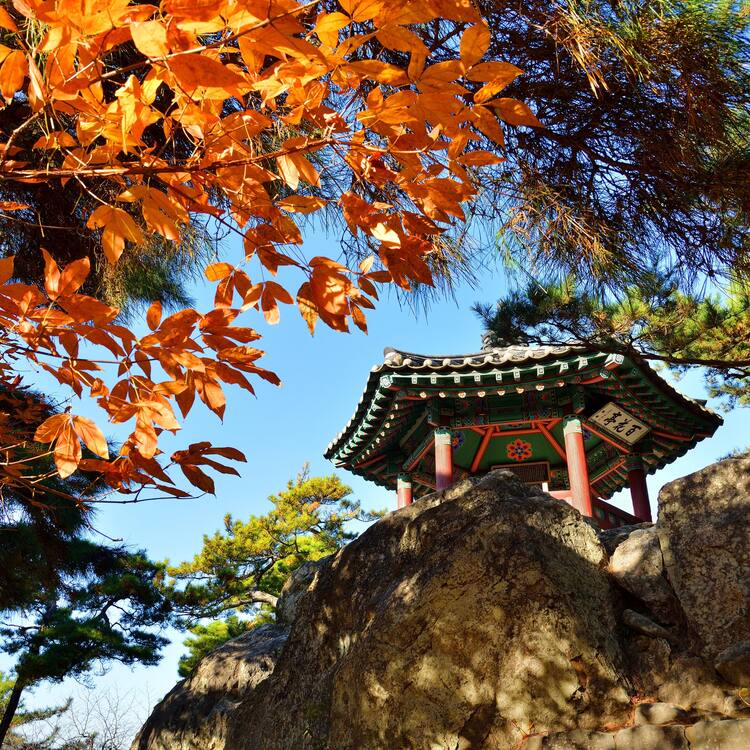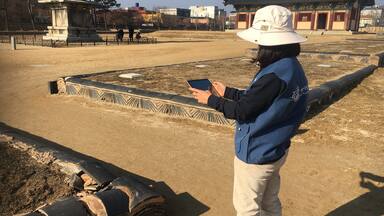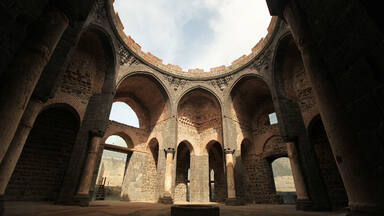Baekje Historic Areas
Baekje Historic Areas
Located in the mountainous mid-western region of the Republic of Korea, this property comprises eight archaeological sites dating from 475 to 660 CE, including the Gongsanseong fortress and royal tombs at Songsan-ri related to the capital, Ungjin (present day Gongju), the Busosanseong Fortress and Gwanbuk-ri administrative buildings, the Jeongnimsa Temple, the royal tombs in Neungsan-ri and the Naseong city wall related to the capital, Sabi (now Buyeo), the royal palace at Wanggung-ri and the Mireuksa Temple in Iksan related to the secondary Sabi capital. Together, these sites represent the later period of the Baekje Kingdom – one of the three earliest kingdoms on the Korean peninsula (18 BCE to 660 CE) - during which time they were at the crossroads of considerable technological, religious (Buddhist), cultural and artistic exchanges between the ancient East Asian kingdoms in Korea, China and Japan.
Description is available under license CC-BY-SA IGO 3.0
Aires historiques de Baekje
Situé dans la région montagneuse du centre-ouest de la République de Corée, ce bien en série comprend huit sites archéologiques datant de 475-660 apr. J.-C : la forteresse Gongsanseong et les tombes royales de Songsan-ri liées à la capitale Ungjin (actuelle Gongju), la forteresse Busosanseong et les bâtiments administratifs Gwanbuk-ri, le temple Jeongnimsa, les tombes royales de Neungsan-ri et les remparts de Naseong liés à la capitale Sabi (actuelle Buyeo), le palais royal de Wanggung-ri et le temple Mireuksa à Iksan, liés à la deuxième capitale Sabi. Ensemble, ils symbolisent la dernière période du royaume de Baekje –l’un des trois premiers royaumes de la péninsule coréenne (18 av. J.-C. à 660 apr. J.-C.)- au cours de laquelle existèrent des échanges technologiques, religieux (bouddhisme), culturels et artistiques considérables entre les anciens royaumes d’Asie de l’Est en Corée, en Chine et au Japon.
Description is available under license CC-BY-SA IGO 3.0
مساحات بايكجي التاريخية
يقع هذا الموقع المتسلسل في المنطقة الجبلية الغربية الوسطى من جمهورية كوريا ويضم ثمانية مواقع أثرية يعود تاريخها إلى الفترة الممتدة من العام 475 إلى العام 660 ميلادية، وهي قلعة غونغسانسيونغ ومدافن سونغسان-ري الملكية المرتبطة بالعاصمة أوندجين (غونغدجو حالياً)، وقلعة بوسوسانسيونغ ومباني غوانبوك-ري الإدارية وأسوار ناسيونغ المرتبطة بالعاصمة سابي (بويو حالياً)، وقصر وانغونغ-ري الملكي ومعبد ميروكسا في إيكسان، المرتبطان بالعاصمة الثانية سابي. وترمز هذه المواقع مجتمعةً إلى الحقبة الأخيرة لمملكة بايكجي التي تمثل إحدى الممالك الثلاث الأولى التي عرفتها شبه الجزيرة الكورية (في الفترة من العام 18 قبل الميلاد إلى العام 660 ميلادية)، وهي حقبة شهدت مبادلات مهمة على الصعيد التكنولوجي والديني (البوذية) والثقافي والفني بين الممالك القديمة لشرق آسيا، في كوريا والصين واليابان.
source: UNESCO/CPE
Description is available under license CC-BY-SA IGO 3.0
百济遗址区
source: UNESCO/CPE
Description is available under license CC-BY-SA IGO 3.0
Историческая область королевства Пэкче
source: UNESCO/CPE
Description is available under license CC-BY-SA IGO 3.0
Zonas históricas del reino de Baekje
source: UNESCO/CPE
Description is available under license CC-BY-SA IGO 3.0
百済歴史地域
source: NFUAJ
Outstanding Universal Value
Brief synthesis
Located in the mountainous mid-western region of the Republic of Korea, the remains of three capital cities collectively represent the later period of the Baekje Kingdom as it reached its peak in terms of cultural development involving frequent communication with neighbouring regions. The Baekje lasted 700 years from 18 BCE to 660 CE and was one of the three earliest kingdoms on the Korean peninsula. The Baekje Historic Areas serial property comprises eight archaeological sites dating from 475-660 CE including the Gongsanseong fortress and royal tombs at Songsan-ri related to the Ungjin capital Gongju; the Archaeological Site in Gwanbuk-ri and Busosanseong Fortress, Jeongnimsa Temple Site, royal tombs in Neungsan-ri and Naseong city wall related to the Sabi capital Buyeo; the Archaeological Site in Wanggung-ri and the Mireuksa Temple Site in Iksan related to the secondary Sabi capital. Together these sites testify to the adoption by the Baekje of Chinese principles of city planning, construction technology, arts and religion; their refinement by the Baekje and subsequent distribution to Japan and East Asia.
Criterion (ii): The archaeological sites and architecture of the Baekje Historic Areas exhibit the interchange between the ancient East Asian kingdoms in Korea, China and Japan in the development of construction techniques and the spread of Buddhism.
Criterion (iii): The setting of the capital cities, Buddhist temples and tombs, architectural features and stone pagodas of the Baekje Historic Areas contribute in forming exceptional testimony to the unique culture, religion and artistry of the kingdom of Baekje.
Integrity
The property components together contain all the elements necessary to embody the values of the property as a whole. The component parts are of sufficient scale to present the historic function of the capital cities and their relationship to their settings. Apart from the pumping station in the vicinity of the northern gate of Busosanseong Fortress and the remaining residential accommodation within the Archaeological Site of Gwanbuk-ri, the sites have not been impacted adversely by development or neglect.
Authenticity
Most elements of the eight component parts of the serial property have suffered human intervention including reparation and restoration to different degrees. Materials and techniques used have largely been traditional. The forms of tombs and temples have been retained. The temple sites are now to some extent islands amongst low scale urban development but the settings of the fortresses and tombs largely retain their forested setting in a mountain landscape.
Protection and management requirements
The property components are all designated as Historic Sites under the Cultural Heritage Protection Act 1962 amended 2012; the Special Act on the Preservation and Promotion of Ancient Cities 2004, amended 2013 and under local government Cultural Heritage Protection Ordinances: Chungcheongnam-do 2002 and Jeollabuk-do 1999. The buffer zones are protected under the Cultural Heritage Protection Act up to 500m from the boundaries of the property components and under the Cultural Heritage Protection Act which limits the height of new buildings to 8 metres.
The property is managed by the Baekje Historic Areas Conservation and Management Foundation with input from central, provincial and local authorities as well as community associations through the Community Council, which in turn co-ordinates three Local Community Councils. The Community Councils set up under the three municipalities of Gongju, Buyeo and Iksan are responsible for conservation and management, utilization and publicity, and coordinating community participation. An overall Conservation and Management Plan for 2015-2019 was developed to integrate all the agencies responsible for the eight components with the aim of ensuring maintenance of Outstanding Universal Value. This is currently being extended to include an overall tourism management strategy for the property as well as a visitor management plan for each component part.


